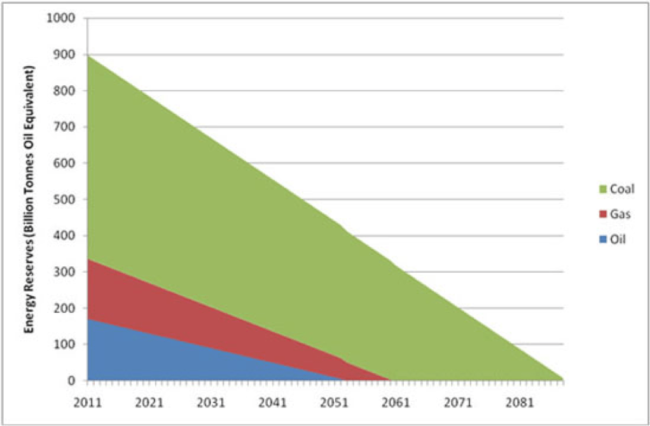Media Type: Article - Recent
Date of Publication: May 2019
Author(s): Gioietta Kuo
Categories: Collapse, Economy, Energy, Environment, Independent Publications
WHY WE SHOULD WORRY
Our world economy is based on the capitalist system which assumes forever a positive Gross Domestic Product – GDP. At the same time 196 governments in December 2017 have signed onto the Paris agreement limiting global temperature rise to less than 2 degrees C by 2100 from the pre-industrial age. IPCC even go as far as stating that the world would benefit with a 1.5 degree C by 2100 giving us a sustainable and equitable development. However already extreme weather is showing devastation in terms of hurricanes, flooding, drought etc … in many parts of the world. Despite all this, governments have not altered their policies in pursuing a higher and higher growth rate [1]. Just a few days ago, we have been told that real GDP in the US increased 3.2 % in the first quarter of 2019 according to the “advance” estimate released by the Bureau of Economic Analysis [2]. In the fourth quarter of 2018, real GDP increased 2.2 percent. Obviously we continue ‘business as usual’ and are not concerned about using up our resources!
Energy consumption worldwide grew by 2.3% in 2018, nearly twice the average rate of growth since 2010, driven by the observed robust economy [3]. More than 40% of the growth in 2017.
Electricity continues to assert itself as the “fuel” of the future, with global electricity demand growing by 4% in 2018 to more than 23,000 TWh. This rapid growth is pushing electricity towards a 20% share in total final consumption of energy. Increasing power generation was responsible for a little more than half of the growth in primary energy demand.
What are the consequences of the higher GDP that we are pursuing?
Yes, we are rapidly depleting our resources. Unfortunately most of the demand for energy falls on the use of fossil energy, oil, gas and coal. With Global energy demand increasing by 2.1% in 2017, as 72% was in fossil fuel [1] [3], 25% in renewables and remainder by nuclear. Naturally this results in a rise in CO2 emission – by 1.7 % in 2017, reaching a historic high of 33.1 gigatons.
LIMIT OF FOSSIL FUELS
In this article we want to point out categorically the fact that there is a LIMIT to the fossil fuels on earth that we are gobbling up. We are oblivious of the fact that there will be a time, measured in decades, when these fuels will run out. Because of global population rise, there is a growing demand for energy. This growth is endangering our future. What will we do when fossil fuels run out? What energy sources can we rely on after this happen?
In figure 1 [4] we show the future energy reserves in billions of oil equivalent, Btoe, as a function of year. While we obliviously use up fossil fuels without taking stock of about what future reserves look like, we should take note of the endpoints shown here. These endpoints are dangerously close: Since our society is so dependent on fossil fuels, it therefore is extremely important for us to know when these fuels will run out according to [4]:
Oil will end by 2052 – 30 years time
Gas will end by 2060 – 40 years time
Coal will last till 2090 – 70 years time
However, according to BP [5], earth has 53 years of oil reserves left at current rate of consumption.
Figure 1 Energy reserves in billion tonnes of oil equivalent – Btoe [4]
According to the 2019 Annual Energy Outlook [6] global GDP growth between 20
メディアの種類 記事・最新情報
発行日 2019年5月
著者(複数) ジョイエッタ・クオ
カテゴリー 崩壊、経済、エネルギー、環境、自主制作本
なぜ心配する必要があるのか
私たちの世界経済は、国内総生産(GDP)が永遠にプラスであることを前提とした資本主義システムに基づいています。同時に、2017年12月に196の政府が、2100年までに世界の気温上昇を産業革命以前から2度C未満に抑えるパリ協定に署名しました。IPCCは、2100年までに1.5度の上昇で世界は恩恵を受け、持続可能で公平な発展がもたらされるとまで述べています。しかし、すでに世界各地でハリケーン、洪水、干ばつなどの異常気象による被害が発生している。このような状況にもかかわらず、各国政府は、より高い成長率を追求する政策を変えていない[1]。つい先日、経済分析局が発表した「事前」推計によると、2019年第1四半期の米国の実質GDPは3.2%増加したと伝えられています[2]。2018年第4四半期は、実質GDPが2.2%増加した。明らかに私たちは「ビジネス・アズ・通常」を続け、資源を使い切ることに無頓着なのです
2018年の世界のエネルギー消費は、観測された堅調な経済に牽引され、2010年以降の平均成長率のほぼ2倍となる2.3%の伸びを示しました[3]。 2017年の伸びの40%以上。
電気は未来の「燃料」として主張し続けており、2018年の世界の電力需要は4%増の23,000TWh以上となりました。この急成長は、エネルギーの総最終消費量における電気のシェアを20%に押し上げつつあります。発電量の増加は、一次エネルギー需要の増加の半分強を担っている。
GDPの向上を追求した結果、どのようなことが起こっているのでしょうか?
そう、私たちは資源を急速に枯渇させているのです。残念ながら、エネルギー需要のほとんどは、石油、ガス、石炭などの化石エネルギーの使用に依存しています。2017年の世界のエネルギー需要は2.1%増加し、72%が化石燃料[1][3]、25%が再生可能エネルギー、残りが原子力発電でした。当然のことながら、これはCO2排出量の増加をもたらします - 2017年に1.7%で、33.1ギガトンの歴史的な高さに到達した。
化石燃料の限界
この記事で私たちは、地球上の化石燃料を食い尽くすには限界があることを明確に指摘したいと思います。私たちは、何十年という単位で、これらの燃料が枯渇するときが来るという事実に気づいていない。世界的な人口増加により、エネルギーに対する需要が高まっています。 この成長は、私たちの未来を危険にさらしているのです。化石燃料が枯渇したとき、私たちはどうすればいいのでしょうか?化石燃料が枯渇したとき、私たちはどうすればいいのでしょうか?
図1[4]は、将来のエネルギー埋蔵量を石油換算で10億Btoeとし、年ごとの推移を示したものである。私たちは、将来の埋蔵量がどのようなものであるかを把握することなく、化石燃料を無意識に使い果たしているが、ここに示された終点に注目する必要がある。この終点は、危険なほど近い。化石燃料に依存した社会である以上、化石燃料がいつ枯渇するのかを知ることは非常に重要なことである。
4]に従っています。
石油は2052年に枯渇する - 30年後
ガスは2060年まで - 40年後
石炭は2090年まで持つ-70年後
しかし、BP社[5]によると、現在の消費量では地球には53年分の石油埋蔵量が残っているという。
図1 エネルギー埋蔵量(石油換算10億トン)-Btoe[4]。
www.DeepL.com/Translator(無料版)で翻訳しました。
